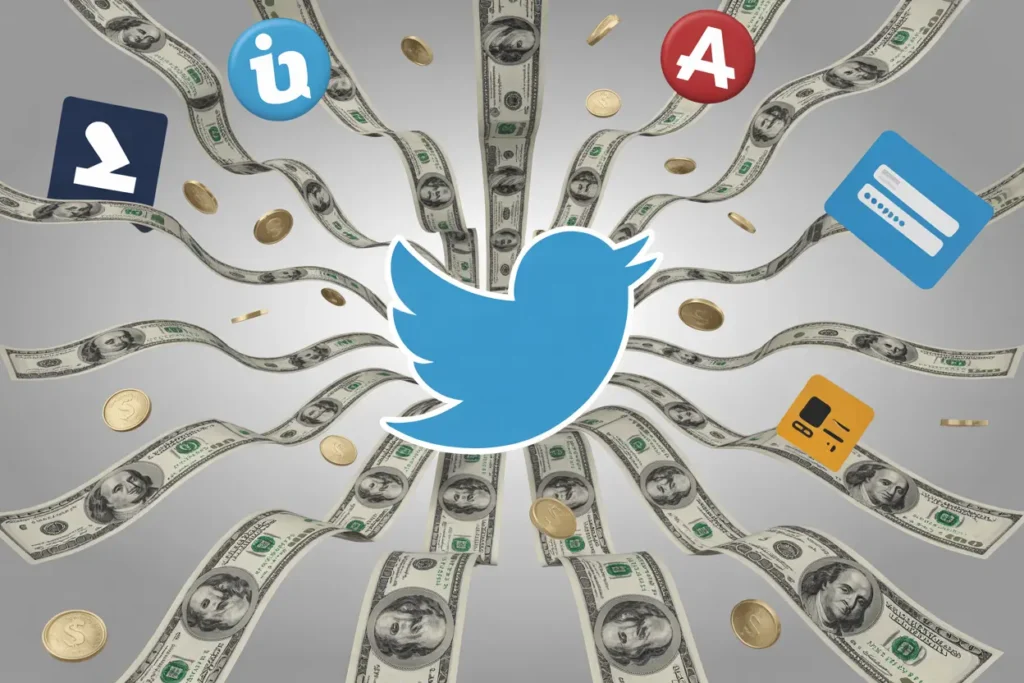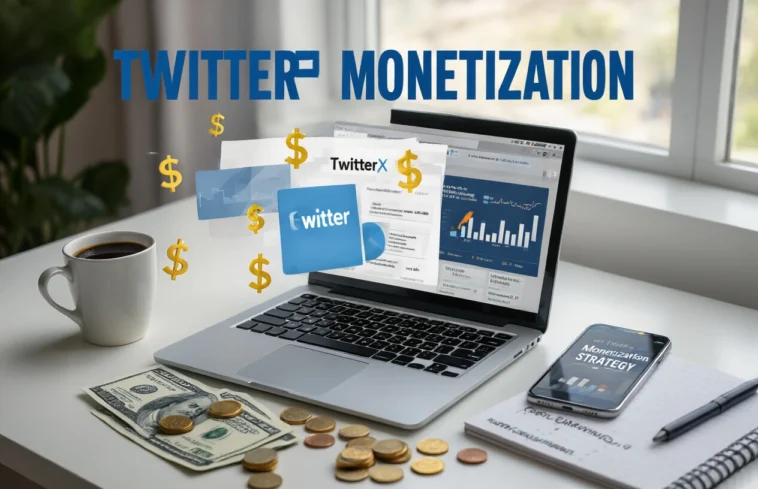Twitter monetization has evolved from a distant dream into a real income opportunity for content creators, businesses, and influencers. This guide is designed for anyone ready to turn their tweets into revenue streams, from established brands looking to expand their reach to individual creators building their first following.
Twitter monetization offers multiple paths to generate income, but success requires understanding the platform’s unique ecosystem and audience behavior. You’ll learn how to build a profitable Twitter monetization presence that attracts engaged followers who convert into customers or supporters.
We’ll explore Twitter’s built-in revenue streams, including how Twitter monetization Blue and premium features can boost your earning potential. You’ll also discover advanced strategies for leveraging sponsored content, affiliate marketing, and creator economy opportunities that turn your social media presence into sustainable income.
Understanding Twitter Monetization Revenue Streams

Advertising Revenue Opportunities
Twitter advertising ecosystem offers multiple pathways for generating income. The platform’s real-time nature makes it incredibly valuable for businesses looking to capture immediate attention and drive quick conversions. You can tap into this through promoted tweets, where your content appears in users’ timelines even if they don’t follow you. The beauty lies in Twitter’s sophisticated targeting options – you can reach people based on their interests, behaviors, demographics, and even specific keywords they’ve searched for recently.
Sponsored trends represent another lucrative opportunity, allowing brands to dominate the conversation around specific topics. These appear at the top of the trending topics list and typically generate massive engagement. For content creators and influencers, this translates to partnership opportunities where brands pay premium rates for authentic endorsements during trending moments.
Twitter’s advertising revenue sharing program also enables eligible creators to earn money directly from ads displayed in replies to their tweets. This creates a passive income stream that grows alongside your audience engagement. The key to maximizing advertising revenue lies in understanding Twitter’s algorithm preferences – content that sparks conversations, generates retweets, and receives quick engagement performs better and commands higher advertising rates.
Subscription-Based Income Models
Twitter monetization Blue and Twitter Blue Premium have revolutionized how creators monetize their presence on the platform. These subscription tiers provide direct revenue sharing opportunities, where eligible creators receive a portion of subscription revenue based on the engagement their content generates from verified users. This model rewards quality content creation and consistent audience engagement rather than just follower count.
Super Follows represents another subscription avenue, allowing creators to charge monthly fees for exclusive content access. Subscribers gain access to special tweets, community features, and direct communication channels. This works particularly well for industry experts, thought leaders, and niche content creators who provide specialized insights or entertainment value.
The subscription model creates predictable, recurring income streams that aren’t dependent on external advertising budgets or brand partnerships. Creators can build sustainable businesses by focusing on delivering consistent value to their paying subscribers. Success in subscription-based models requires understanding your audience’s pain points and consistently delivering content that solves problems or provides unique perspectives they can’t find elsewhere for free.
Creator Twitter Monetization Programs
Twitter Creator Monetization programs have expanded significantly, offering multiple revenue streams for content creators. The Creator Fund distributes payments to eligible creators based on tweet impressions and engagement metrics from verified users. This program specifically targets creators who consistently produce high-quality, original content that drives meaningful conversations on the platform.
Spaces monetization allows creators to host paid audio conversations, similar to premium podcasts or exclusive seminars. Hosts can charge admission fees for live Spaces events, creating opportunities for thought leadership, education, and entertainment monetization. This feature works exceptionally well for industry experts, coaches, and entertainers who can provide unique insights or experiences worth paying for.
Twitter monetization Tips feature enables direct fan support through integrated payment systems. Creators can receive one-time payments from appreciative followers, creating a crowdfunding-like experience. The platform supports multiple payment methods including traditional payment processors and cryptocurrency options, making it accessible to global audiences. These programs work best when creators maintain authentic relationships with their audiences and consistently deliver value that goes beyond typical social media content.
E-commerce Integration Possibilities
Twitter monetization shopping features transform the platform into a powerful sales channel for businesses and individual entrepreneurs. Product tags allow businesses to showcase items directly in tweets, creating seamless shopping experiences that don’t require users to leave the platform. This integration works particularly well for visual products, limited-time offers, and impulse purchase items.
The platform’s real-time nature makes it ideal for flash sales, product launches, and exclusive offers. Businesses can create urgency and drive immediate sales through strategic tweet timing and hashtag usage. Customer service integration also plays a crucial role in e-commerce success on Twitter – responsive support through direct messages and public replies builds trust and encourages repeat purchases.
Twitter’s integration with major e-commerce platforms like Shopify enables automated product promotion and inventory management. This allows businesses to maintain active social selling without constant manual oversight. The platform’s analytics provide valuable insights into which products resonate with audiences, optimal posting times, and conversion tracking that helps refine e-commerce strategies over time.
Building Your Twitter Presence for Profit

Optimizing Your Profile for Maximum Engagement
Your Twitter monetization profile serves as your digital storefront, and getting it right can make the difference between gaining followers and being ignored. Start with a professional headshot that clearly shows your face – people connect with people, not logos or abstract images. Your bio needs to pack a punch in 160 characters, so craft it carefully. Include keywords related to your expertise, a clear value proposition, and maybe a touch of personality. Pin a tweet that showcases your best work or introduces newcomers to what you offer.
Your username should be memorable and professional. If your name isn’t available, consider adding your industry or expertise. Link to your website, newsletter, or latest project in your bio link. Twitter’s header image gives you prime real estate to showcase your brand, so use it to highlight your services, recent achievements, or upcoming events.
Creating Content That Attracts Followers
Consistency beats perfection every time on Twitter monetization . Develop a content calendar and stick to posting regularly – aim for 3-5 tweets daily. Mix up your content types: share insights, ask questions, reply to others, and retweet valuable content with your own commentary added.
Tweet threads perform exceptionally well for complex topics. Break down your expertise into digestible, numbered tweets that provide real value. Start with a hook that makes people want to read more, then deliver actionable insights. End with a call-to-action asking for retweets or follows.
Engage authentically with others in your space. Reply to tweets with thoughtful comments, not just generic praise. Share other people’s content with your perspective added. Join Twitter chats relevant to your niche – they’re goldmines for connecting with like-minded people.
Visual content gets more engagement, so include images, GIFs, or videos when possible. Tools like Canva make creating professional graphics simple. Screenshots of interesting articles, behind-the-scenes photos, or quick video tips can boost your visibility significantly.
Establishing Your Niche and Expertise
Pick your lane and own it. Trying to be everything to everyone dilutes your message and confuses potential followers. Choose 2-3 related topics you’re genuinely passionate and knowledgeable about. This focus helps Twitter’s algorithm understand what you offer and who should see your content.
Share your learning journey openly. People love following along as someone builds expertise or grows their business. Document your wins, failures, and lessons learned. This transparency builds trust and makes you more relatable than those who only share polished success stories.
Position yourself as a curator of valuable information in your niche. Share relevant news, studies, and insights from others, always adding your own perspective. Become the person others turn to for the latest developments in your field.
Create signature content that people associate with you. Maybe it’s Monday motivation posts, Friday industry roundups, or weekly tip threads. These recurring formats help build anticipation and give followers a reason to keep coming back. Your unique voice and perspective on common industry topics will set you apart from the crowd.
Twitter Ads and Sponsored Content Strategies

Setting up effective Twitter ad campaigns
Creating successful Twitter ad campaigns starts with defining clear objectives. Whether you want to drive website traffic, increase brand awareness, or generate leads, your campaign structure should align with these goals. Twitter’s campaign objectives include reach, video views, engagements, followers, website clicks, and app installs.
Start by selecting the right campaign objective that matches your business goals. For e-commerce businesses, website clicks or conversions work best. Content creators might focus on engagement or follower campaigns. Each objective optimizes your ad delivery differently, so this choice impacts your entire campaign performance.
Budget allocation requires strategic thinking. Twitter monetization offers daily and total budget options, with automatic bidding often delivering better results than manual bidding for beginners. Start with smaller budgets to test your approach before scaling successful campaigns.
Your ad creative makes or breaks campaign performance. Twitter users scroll quickly, so your content needs to grab attention immediately. Use high-quality images or videos, write compelling copy that speaks directly to your audience’s pain points, and include clear calls-to-action. Native-looking content that blends seamlessly into users’ feeds typically outperforms obvious advertisements.
Test multiple ad variations simultaneously. Create different headlines, images, and copy versions to identify what resonates with your audience. Twitter’s A/B testing features help you compare performance and optimize based on real data rather than assumptions.
Partnering with brands for sponsored posts
Brand partnerships on Twitter require authentic relationships and strategic positioning. Companies actively seek influencers and content creators who align with their values and can reach their target demographics effectively.
Building your personal brand comes first. Brands want partners with engaged, authentic audiences who trust their recommendations. Focus on creating valuable content consistently, engaging genuinely with your followers, and establishing yourself as an authority in your niche. Your follower count matters less than engagement rates and audience quality.
Reach out to brands proactively rather than waiting for opportunities to come to you. Research companies that align with your values and audience. Look at their existing partnerships and social media presence to understand their marketing style. Craft personalized pitches that highlight specific value you can provide, including your audience demographics, engagement rates, and content ideas.
Pricing your sponsored content appropriately protects your credibility and ensures fair compensation. Industry standards suggest charging $10-100 per 1,000 followers, but engagement rates, niche expertise, and content quality should influence your rates more than follower count alone.
Maintain transparency with your audience by clearly disclosing sponsored partnerships using #ad or #sponsored hashtags. This builds trust and complies with FTC guidelines. Create sponsored content that provides genuine value to your followers while meeting brand objectives.
Negotiate contract terms carefully. Specify deliverables, timelines, usage rights, and payment terms upfront. Some brands want exclusive content, while others allow repurposing. Understanding these details prevents conflicts and ensures smooth partnerships.
Measuring ROI on advertising spend
Tracking return on investment requires setting up proper measurement systems before launching campaigns. Twitter’s analytics dashboard provides essential metrics, but connecting external tracking tools gives you deeper insights into customer behavior and conversion paths.
Install Twitter’s conversion tracking pixel on your website to monitor post-click actions. This pixel tracks when users who clicked your ads complete desired actions like purchases, sign-ups, or downloads. Without proper tracking, you’re essentially flying blind with your ad spend.
Focus on metrics that directly relate to your business objectives. Click-through rates and impressions look impressive but don’t necessarily translate to revenue. Conversion rates, cost per acquisition, and lifetime customer value provide clearer pictures of campaign profitability.
| Metric | What It Measures | Why It Matters |
|---|---|---|
| Cost Per Click (CPC) | Average amount paid per click | Budget efficiency |
| Conversion Rate | Percentage of clicks that convert | Campaign effectiveness |
| Cost Per Acquisition (CPA) | Cost to acquire one customer | Profitability indicator |
| Return on Ad Spend (ROAS) | Revenue generated per dollar spent | Overall campaign success |
Calculate your customer lifetime value to determine acceptable acquisition costs. If customers typically spend $200 over their relationship with your business, paying $50 to acquire them through Twitter ads might be profitable. Without this context, you can’t make informed bidding decisions.
Set up attribution windows that make sense for your business model. Twitter’s default attribution might not capture customers who research on Twitter but purchase days later through other channels. Adjust attribution settings to better reflect your actual customer journey.
Best practices for ad targeting
Precision targeting maximizes your ad budget by showing content to users most likely to engage or convert. Twitter’s targeting options include demographics, interests, behaviors, keywords, and lookalike audiences based on your existing customers.
Start with broader targeting to gather data, then narrow your focus based on performance insights. Overly specific targeting can limit your reach and increase costs, while too broad targeting wastes money on irrelevant audiences. Find the sweet spot through testing and optimization.
Interest targeting works particularly well on Twitter because users actively follow accounts and engage with topics they care about. Layer multiple interests to create more refined audiences. Someone interested in both “sustainable fashion” and “yoga” might be perfect for an eco-friendly activewear brand.
Keyword targeting lets you reach users based on their recent tweets and engagement patterns. Target keywords related to your products, competitors, or industry topics. Someone tweeting about needing new running shoes presents an immediate opportunity for athletic brands.
Lookalike audiences help you find new customers similar to your existing ones. Upload your customer email list or website visitors to create audiences with similar characteristics. These audiences often convert better than interest-based targeting because they’re based on actual customer behavior rather than stated preferences.
Geographic targeting becomes crucial for local businesses or region-specific campaigns. Don’t just target by country – narrow down to states, cities, or postal codes when relevant. A restaurant chain should target specific metropolitan areas rather than entire countries.
Exclude audiences that aren’t relevant to avoid wasted impressions. If you sell premium products, you might exclude users who frequently engage with discount-focused accounts. Negative targeting helps refine your audience and improve conversion rates.
Test different targeting combinations systematically. Run separate campaigns for different audience segments to identify which groups respond best to your offers. This data informs future targeting decisions and budget allocation strategies.
Leveraging Twitter Blue and Premium Features

Maximizing Twitter Blue subscription benefits
Twitter Blue transforms your social media experience from basic tweeting into a professional content creation and business tool. The subscription service offers priority customer support, which means faster response times when you encounter technical issues that could impact your monetization efforts. Your tweets gain higher visibility through algorithmic boosts, placing your content in front of more potential customers and followers.
The verification checkmark that comes with Twitter Blue carries significant weight in building credibility. Users are more likely to engage with verified accounts, leading to higher click-through rates on your promotional content and affiliate links. This enhanced trust factor directly translates to increased conversion rates for your products or services.
Edit functionality allows you to polish your tweets after posting, maintaining a professional image that’s crucial for business accounts. Instead of deleting and reposting tweets that contain typos or need refinement, you can make corrections while preserving engagement metrics like likes and retweets.
The bookmark organization feature helps you curate content ideas and competitor research more efficiently. Create folders for different monetization strategies, industry trends, and potential collaboration opportunities. This systematic approach to content planning saves time and ensures you never miss valuable insights that could drive revenue.
Utilizing exclusive features for business growth
Longer tweet limits give you more space to craft compelling sales messages without the constraints of character count. You can include detailed product descriptions, customer testimonials, and call-to-action text within a single tweet, reducing the need for lengthy threads that might lose readers’ attention.
The NFT profile picture feature positions you at the forefront of digital trends, appealing to crypto and tech-savvy audiences. This demographic often has higher disposable income and willingness to invest in innovative products or services. Your hexagonal profile picture serves as a conversation starter and differentiates your brand in crowded timelines.
Reader mode transforms long-form tweets into article-style layouts, making your educational content more digestible and professional-looking. This feature is particularly valuable for coaches, consultants, and thought leaders who share detailed insights as part of their content marketing strategy.
Priority ranking in conversations ensures your replies appear prominently under popular tweets. This visibility boost is invaluable when engaging with industry influencers or participating in trending discussions related to your niche. Strategic participation in high-engagement conversations can attract new followers and potential customers to your profile.
Custom app icons and themes might seem cosmetic, but they contribute to brand consistency across all your digital touchpoints. Professional appearance details matter when potential clients evaluate your credibility before making purchasing decisions.
Understanding pricing tiers and value propositions
Twitter Blue’s pricing structure varies by region and platform, with web subscriptions typically offering better value than mobile app purchases due to app store fees. The basic tier provides essential features like edit buttons and verification, while higher tiers unlock advanced analytics and expanded reach capabilities.
| Feature | Basic Blue | Blue Plus | Enterprise |
|---|---|---|---|
| Verification checkmark | ✓ | ✓ | ✓ |
| Edit tweets | ✓ | ✓ | ✓ |
| Longer tweets | ✓ | ✓ | ✓ |
| Priority support | Limited | Enhanced | 24/7 |
| Analytics access | Basic | Advanced | Custom |
| API access | No | Limited | Full |
The return on investment becomes clear when you calculate the value of increased engagement rates. A verified account typically sees 20-30% higher engagement compared to unverified profiles. If your tweets generate leads or direct sales, this engagement boost can quickly justify the subscription cost.
Annual subscriptions offer cost savings compared to monthly payments, making them attractive for committed content creators and businesses. The discount percentage varies but typically ranges from 10-15% off the total yearly cost.
For businesses running multiple brand accounts, the ability to verify each profile separately creates a professional ecosystem that builds trust across all customer touchpoints. The cumulative effect of verified status across multiple accounts amplifies your brand’s authority and reach within your industry.
Creator Economy Opportunities on Twitter

Joining Twitter’s Creator Fund program
Twitter’s Creator Fund represents a direct pathway to earning money from your content creation efforts. The platform launched this initiative to share advertising revenue with eligible creators who consistently produce engaging content. To qualify, you need at least 500 followers, maintain an active posting schedule, and comply with Twitter’s community guidelines.
The application process involves submitting examples of your best content and demonstrating your ability to drive meaningful engagement. Twitter evaluates creators based on content quality, audience interaction rates, and overall contribution to platform conversations. Once accepted, you’ll receive monthly payments based on impressions, engagement metrics, and the overall performance of your tweets.
Successful Creator Fund participants often focus on niche topics where they can establish authority. Tech reviewers, political commentators, and industry experts tend to perform well because their content generates sustained discussions and repeat engagement from dedicated followers.
Monetizing through Super Follows
Super Follows allows your most dedicated fans to pay a monthly subscription fee for exclusive content and perks. You can set pricing tiers ranging from $2.99 to $9.99 per month, giving subscribers access to bonus tweets, behind-the-scenes content, and direct communication opportunities.
The key to successful Super Follows monetization lies in creating genuine value for subscribers. This might include:
- Exclusive industry insights that aren’t available in your public tweets
- Early access to your thoughts on trending topics
- Personal updates that give subscribers a closer connection to you
- Subscriber-only polls where they can influence your content direction
Content creators who earn significant Super Follows revenue typically maintain a clear content calendar and consistently deliver on their promises to subscribers. They also actively engage with their paying audience through replies and direct messages, creating a sense of community that justifies the monthly expense.
Selling digital products and services
Twitter serves as an excellent platform for promoting and selling digital products directly to your audience. The real-time nature of the platform makes it perfect for announcing product launches, sharing customer testimonials, and building anticipation around new offerings.
Popular digital products that perform well on Twitter include:
| Product Type | Best Practices | Typical Price Range |
|---|---|---|
| E-books | Share chapter previews, writing process | $9.99 – $49.99 |
| Online courses | Post free mini-lessons, student success stories | $99 – $997 |
| Templates | Show before/after examples, use cases | $19 – $199 |
| Consultations | Share case studies, expertise demonstrations | $150 – $500/hour |
The most successful sellers use Twitter to build trust and authority in their niche before making sales pitches. They share valuable free content regularly, respond to questions in their field, and position their paid products as natural extensions of their expertise.
Service-based businesses can use Twitter threads to showcase their problem-solving abilities, making potential clients more likely to hire them for consulting, coaching, or freelance work.
Building recurring revenue streams
Recurring revenue creates financial stability and allows you to focus on content creation rather than constantly seeking new customers. Twitter offers several ways to build these sustainable income streams.
Membership communities represent one of the most profitable recurring models. You can use Twitter to promote Discord servers, Circle communities, or Substack newsletters where members pay monthly fees for ongoing access to exclusive content and networking opportunities.
Many creators combine multiple recurring streams:
- Newsletter subscriptions promoted through Twitter threads
- Monthly coaching calls sold to Super Follows subscribers
- Community memberships where Twitter serves as the discovery channel
- Affiliate partnerships that generate ongoing commissions
The creators earning five-figure monthly recurring revenue typically spend 18-24 months building their audience and testing different monetization approaches. They track which types of content drive the most sign-ups and double down on those formats.
Email list building through Twitter remains crucial for recurring revenue success. By offering valuable lead magnets and consistently driving followers to join their email lists, creators can market recurring offers directly to interested prospects without depending entirely on Twitter’s algorithm for visibility.
Advanced Monetization Techniques
Cross-platform promotion strategies
Twitter works best when it’s part of a bigger content ecosystem. Smart creators build bridges between platforms, using each one’s strengths to drive growth everywhere else.
Start by repurposing your Twitter content across different platforms. That thread you wrote about productivity tips? Turn it into a LinkedIn article, an Instagram carousel, or a YouTube short. Your viral tweet can become the hook for a TikTok video or the opening line of your newsletter. The key is adapting the format, not just copying and pasting.
Create platform-specific teasers that point back to Twitter. Post a snippet of your Twitter thread on Instagram Stories with “Read the full thread on Twitter” or share a screenshot of an interesting tweet on Facebook with your commentary. This strategy works particularly well for driving traffic from visual platforms to your text-based Twitter content.
Build consistent branding across all platforms using the same handle, profile picture, and color scheme. When people see your content on Instagram, they should instantly recognize you on Twitter. This recognition builds trust and makes cross-platform discovery feel natural.
Use Twitter as your real-time hub. When you go live on other platforms, tweet about it. When you publish a YouTube video, share key takeaways in a Twitter thread. When you launch a podcast episode, quote the best moments on Twitter. This approach positions Twitter as your content command center.
Track which cross-platform promotions drive the most engagement and followers. Some audiences respond better to direct calls-to-action, while others prefer subtle mentions. Test different approaches and double down on what works for your specific audience mix.
Email list building through Twitter
Email remains one of the highest-converting marketing channels, and Twitter provides multiple ways to grow your subscriber base organically. The platform’s real-time nature makes it perfect for capturing people when they’re most engaged with your content.
Pin a tweet offering a valuable lead magnet – a free guide, checklist, or exclusive content that requires email signup. Make this your permanent pinned tweet and update it periodically to keep it fresh. Include a clear value proposition explaining exactly what subscribers will get and why they should care.
Use Twitter threads strategically to build email signups. End valuable threads with a call-to-action like “Want more insights like this delivered weekly? Link in bio to join 5,000+ readers.” People who read entire threads are highly engaged and more likely to convert.
Host Twitter Spaces or participate in conversations where you can naturally mention your newsletter. When you share valuable insights during live audio, follow up with “I write about this stuff weekly – link in bio if you want to dive deeper.” The real-time connection makes people more likely to take action.
Create Twitter-exclusive previews of your newsletter content. Share a fascinating stat or insight, then say “This is from this week’s newsletter – subscribe to get the full analysis.” This approach works because you’re giving value upfront while creating curiosity for more.
Run Twitter polls asking your audience about their biggest challenges or interests. Use the responses to create targeted lead magnets that directly address their needs. When someone votes for “productivity tips,” you can reply with a link to your productivity newsletter signup.
Set up automated direct messages for new followers, but make them personal and valuable. Instead of generic “thanks for following,” try “Thanks for the follow! I send my best Twitter growth tips to subscribers weekly – grab the free guide here: [link].”
Affiliate marketing integration
Affiliate marketing on Twitter monetization requires a delicate balance between providing value and making money. The platform’s conversational nature means hard sells backfire quickly, but genuine recommendations can drive significant revenue.
Build trust before promoting anything. Share valuable content consistently for weeks or months before introducing affiliate products. Your audience needs to see you as a helpful expert, not a salesperson. When you do promote something, they’ll trust it comes from a place of genuine recommendation rather than pure profit motive.
Focus on products you actually use and love. Your enthusiasm will come through in your tweets, and you’ll be able to answer questions authentically. If someone asks about your experience with a tool you’re promoting, you should have real stories and specific examples ready.
Use Twitter monetization thread format to create detailed product reviews or tutorials. Break down exactly how you use a tool, what results you’ve gotten, and who would benefit most from it. End the thread with your affiliate link and a clear disclosure. This approach provides massive value while naturally leading to conversions.
Time your affiliate promotions strategically. Black Friday, end-of-month sales, and New Year planning periods often see higher conversion rates. Monitor when your audience is most active and engaged, then schedule your promotional content for those peak times.
Create comparison threads between different tools in your niche. This type of content performs well because it helps people make decisions. Include your affiliate links for multiple products, but be transparent about which ones you personally prefer and why.
Track your affiliate performance religiously. Twitter monetization Analytics shows which tweets drive the most link clicks, but you’ll need your affiliate dashboard to see which clicks convert to sales. Test different approaches – direct links versus link-in-bio, threads versus single tweets, morning versus evening posting – and optimize based on actual revenue data.
Engage with replies and questions on your affiliate tweets. People often have specific questions before buying, and your responses can push them over the edge. This engagement also signals to Twitter’s algorithm that your content is valuable, increasing its reach to potential customers.
Conclusion

Twitter monetization offers creators multiple ways to turn their social media presence into real income. From the basic Twitter Blue subscription perks to advanced creator funds and sponsored partnerships, the platform has evolved into a genuine business opportunity for those willing to put in the work. Building a strong follower base remains the foundation, but smart creators also focus on engagement rates, niche expertise, and authentic connections with their audience.
The key to Twitter monetization success lies in diversifying your approach. Don’t rely on just one revenue stream – combine affiliate marketing with sponsored posts, use Twitter Spaces for premium content, and explore the platform’s built-in creator tools. Start small, test what works for your audience, and scale up gradually. Your Twitter account can become a profitable side hustle or even a full-time income source, but it requires consistent effort, genuine value creation, and patience to see real results.





GIPHY App Key not set. Please check settings